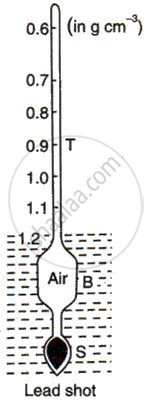Advertisements
Advertisements
प्रश्न
Name an instrument based on this principle. State two uses of the instrument that you describe.
उत्तर
A hydrometer is based on the principle of floatation.
A hydrometer is a device used for measuring the relative densi ty of a liquid directly.

Hydrometer
It usually consists of a glass float with a long thin stem which is graduated. The glass float is a large hollow bulb which increases with buoyancy. The narrow stem increases the sensitivity of hydrometer. The bottom of the hydrometer is made heavier by loading it with lead shots so that it floats vertically.
The hydrometer works on the principle of floatation. Consider a thin-walled and flat bottomed test tube. Add some lead shots in the test tube and place it in a jar containing water. Adjust the number of lead shots such that it floats vertically with some of its portion outside the surface of the water in a jar.
If l is the length of the test tube inside water, a is an area of cross-section of the test tube, d is the density of water in which it floats, then the weight of water displaced = aldg and it is equal to the weight of loaded test tube.
Now allow the test tube to float in the other jar filled with a liquid of density d1 and note the level l1 at which it floats in that liquid.
Weight of the liquid displaced = al1d1g
Using the law of floatation
aldg = al1d1g
Id = l1d1
l/l1 = d1/d
or l is inversely proportional to the density.
It sinks more in a lighter liquid so as to displace more volume of the lighter liquid whose weight is equal to the weight of Hydrometer. Hence, it will sink less in a denser liquid so that it has displaced less volume of the denser liquid whose weight will be equal to the hydrometer.
In this way, this measure relative density of a liquid Barometer can be used as a lactometer which can be used to check the purity of milk.
The barometer can be used as an acid battery hydrometer which can be used to check the concentration of sulphuric acid in an acid battery.
APPEARS IN
संबंधित प्रश्न
A body is held immersed in a liquid. (i) Name the two forces acting on the body and draw a diagram to show these forces. (ii) State how the magnitudes of two forces mentioned in part (i) determine whether the body will float or sink in liquid when it is released. (iii) What is the net force on the body if it (a) sinks and (b) floats?
A piece of ice floating in a glass of water melts, but the level of water in the glass does not change.
Give reasons.
Hint: Ice contracts on melting.
A body floats in a liquid A of density ρ1 with a part of it submerged inside the liquid, while in liquid B of density ρ2 it is totally submerged inside the liquid. The densities ρ1 and ρ2 are related as :
A test tube weighing 17 gf, floats in alcohol to the level P. When the test tube is made to float in water to the level P, 3 gf of the lead shots are added in it. find the R.D. of alcohol.
A rubber ball floats in water with 2/7 of its volume above the surface of the water. Calculate the average relative density of the rubber ball.
A block of wood of volume 25 cm3 floats in water with 20 cm3 of its volume immersed in water.
Calculate:
(1) density of wood
(2) the weight of block of wood.
Explain the following:
An egg sinks in fresh water but floats in a strong solution of salt.
State the laws of flotation.
Where do we use lactometers?
Name different types of Hydrometers with their applications.
